Double Bowl Kitchen Sinks are a blessing for multitaskers. Not only do they save your time by creating an uninterrupted workspace, but also they increase your efficiency in doing chores.
In addition, you can simultaneously do multiple activities in a double bowl kitchen sink. We discussed more about double bowl sinks in our article on Single Bowl vs. Double Bowl Kitchen Sinks.
Here, we will analyze three types of double bowl sinks and help you decide which one is the most appropriate for you to get.
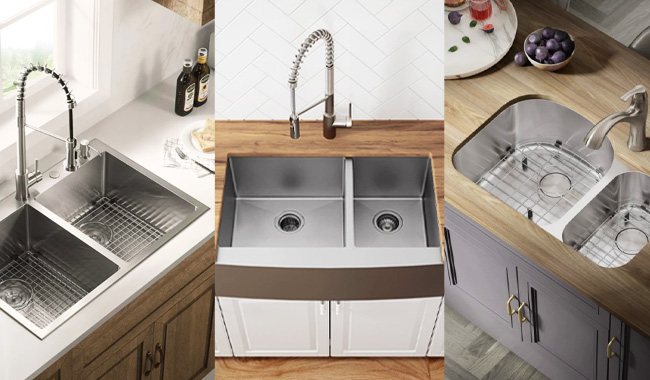
50/50 Vs. 60/40 Vs. 70/30 Kitchen Sinks: Side-by-Side Comparisons
| Kitchen Sink Bowl Type | 50/50 Kitchen Sink | 60/40 Kitchen Sink | 70/30 Kitchen Sink |
| Size and Shape | Ideal Size: around 30 inches wide; Mostly zero-radius and box-shaped. | Ideal Size: around 30 inches wide Available in multiple shape variations, oval and square. | Perfect Size: about 30 inches wide; 70/30 sinks can be 2-3 inches larger. |
| Cabinet Space | Ideal Size: 35 inches wide and 40 inches deep; Around 32 inches width may suffice for 50/50 sinks | Ideal Size: 35 inches wide and 40 inches deep | Perfect Size: 35 inches wide and 40 inches deep |
| Functionality | Basic Multitasking Chores | More oversized Sink that allows broader multitasking; A suitable alternative to drying racks | Work as a single unit alternative to Kitchen Sink and Bar Sink combinations |
| Appropriate Utensils | Small and Medium dishes and utensils | Small, Medium, and Large plates and utensils | Small, Medium, Large, and Extra Large dishes and utensils |
| Accessories | Can accommodate essential accessories such as drying racks, baskets, and grids; Limited Installation space | Can accommodate essential accessories such as drying racks, baskets, and grids; Standard Installation space | Can accommodate essential accessories such as drying racks, baskets, and grids; Extra Installation space for setting up more accessories |
| Price | $150 – $500 | $200 – $700 | $250 – $600 |
What is the Main Difference?
50/50 Kitchen Sinks offer standard functionalities for multitasking chores, and 60/40 Kitchen Sinks have larger space that can accommodate bigger dishes and utensils.
In addition, extra-large dishes can fit 70/30 Kitchen Sinks, and this double bowl sink can function as an alternative to kitchen sink and bar sink combinations in the kitchen.
What is a 50/50 Kitchen Sink?
A 50/50 double bowl kitchen sink has equally separated basins. It offers symmetry in its design, and generally, these sinks are rectangular shaped with flat surfaces. Cleaning small to medium-sized dishes is suitable in this kitchen sink.
What is a 60/40 Kitchen Sink?
A 60/40 double bowl kitchen sink is a type of offset kitchen sink. Sinks like this are designed asymmetrically, and they are designed not only in rectangular shapes but also in oval curved forms.
You can fit in larger kitchen utensils to clean in these sinks along with other smaller sizes.
What is a 70/30 Kitchen Sink?
A 70/30 double bowl kitchen sink is the closest alternative to a separate kitchen sink and bar sink combination in your kitchen. This is also referred to as an offset sink, and it comes with similar designs as a 60/40 kitchen sink.
Its larger basin has enough space for washing the dirt off utensils while keeping clean ones aside. And its secondary basin can act as a bar sink for prepping, drying, and similar activities.
Distinguishing Factors Between 50/50 vs 60/40 vs 70/30 Kitchen Sinks
We found six essential factors you should consider to see which type of double bowl kitchen sink is appropriate for your usage.
- Size and Shape
- Cabinet Space
- Functionality
- Appropriate Utensils
- Accessories
- Price
Size and Shape
The size and shape of all three double bowl sinks are almost similar, with a few exceptions in the 50/50 kitchen sink and 70/30 kitchen sink. Those are,
- Most of the 50/50 Kitchen Sinks are structured as zero radius sinks, with no curved edges
- 70/30 are 2-3 inches larger than other double bowl sinks
Apart from that, the ideal size of these double bowl sinks is generally around 30 inches wide. And a variation of shapes, such as being oval and unorthodox, is available in the case of all three sinks.
Cabinet Space
The best cabinet space for the three double bowl sinks should be around 35 inches wide and 40 inches deep.
However, some exceptions can be made for 50/50 sinks, as it does not take up much cabinet space; in that case, a size around 32 inches would suffice.
Functionality
- 50/50 Kitchen Sinks: 50/50 Kitchen sinks; generally, one basin is used to clean dirt off the dishes and prepping, while the other is used to keep already cleaned dishes dry.
- 60/40 Kitchen Sinks: 60/40 Kitchen sinks offer quicker accessibility for drying, washing dishes, and preparation. Its more extensive basin work as an alternative to separate drying racks and baskets.
- 70/30 Kitchen Sinks: 70/30 Kitchen sinks operate like a kitchen sink and a bar sink. These sinks function as a single unit, and you can do more than two tasks simultaneously in these sinks. Similar to 60/40 Kitchen Sinks, its larger basins are an alternative to different accessories.
Appropriate Utensils
- 50/50 Kitchen Sinks: 50/50 Kitchen sinks can accommodate small to medium-sized dishes and utensils.
- 60/40 Kitchen Sinks: Small, medium, and large dishes are suitable to clean in a 60/40 kitchen sink.
- 70/30 Kitchen Sinks: Small, medium, large, and certain extra large dishes and utensils can fit the larger basin of a 70/30 Kitchen Sink.
Accessories
Both 50/50 and 60/40 kitchen sinks can accommodate all necessary accessories that come with a kitchen sink, such as drying racks, dish holders, grids, and more, as discussed in our Kitchen Sink Buying Guide.
However, in the case of 70/30 Kitchen Sinks, more variations of accessories can be accommodated. For example, the larger basin of a 70/30 sink can have two accessories set up. So, combinations like two drying racks in the more oversized sink and a small basket in the secondary sink are possible.
Price
All three of these kitchen sink bowl types are priced from USD 200 to USD 700 as standard.
Pros and Cons of 50/50 Kitchen Sinks
Pros
- 50/50 Kitchen Sinks are symmetrically designed, and most have a sharp modern style
- These sinks are suitable for kitchen chores that involve small to medium-sized dishes and utensils
- Offers flexibility in multitasking
Cons
- It cannot accommodate larger utensil
- Installing accessories is difficult because of limited space
- Difficulty cleaning because of sharp, structured edges
Pros and Cons of 60/40 Kitchen Sinks
Pros
- 60/40 Kitchen Sinks offer more flexibility in terms of structure and design
- These sinks can fit in larger utensils for cleaning
- Offers greater work flexibility
- Accessibility is quicker when using a 60/40 kitchen sink for multitasking
Cons
- Limited accommodation to large pots and pans
- Requires larger cabinet space to be installed properly
Pros and Cons of 70/30 Kitchen Sinks
Pros
- Functions as a single unit alternative to the kitchen sink, and bar sink combinations
- 70/30 Kitchen Sinks can adequately accommodate larger dishes
- Offers greater flexibility in multitasking
- Quicker accessibility is also applicable for this type of sink
- More accessories can be installed
Cons
- Requires larger cabinet space to be installed properly
- Comparatively more expensive among kitchen sink bowls
FAQs
- Is a divided sink better?
A divided sink is excellent for multitasking activities and compartmentalizing the workspace.
- What is a 60/40 kitchen sink?
A 60/40 kitchen sink is an offset kitchen sink designed asymmetrically to have a larger basin as a primary sink and a smaller basin as a secondary sink.
- Which is better: 50/50, 60/40, and 70/30 kitchen sink?
Depending on your specific chores, all three types of double bowl sinks are excellent in their purposes. However, 70/30 Kitchen Sinks are preferable for their capability to hold more dishes and accessories.
- What is the purpose of a 70/30 sink?
A 70/30 Kitchen Sinks’s primary purpose is to function as a single unit sink that can fulfill the tasks of a primary kitchen sink and a bar sink. In addition, it allows multitasking while cleaning larger dishes and utensils.
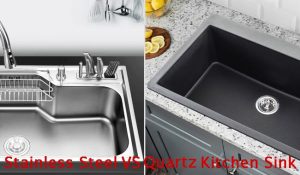
Stainless Steel Sink vs. Quartz Sink: Which is Better for Your Kitchen?
Are you planning on renovating the kitchen? You may have had some thoughts concerning the sink. And it’s quite evident that the most frequently used in
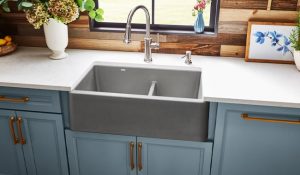
Different Types of Kitchen Sinks in Detail
Till today I had no idea that there are so many types of kitchen sink available in the market. If you are about to renovate
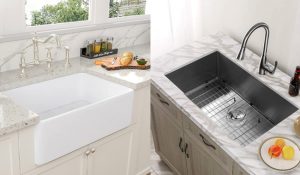
Porcelain Vs. Stainless Steel Kitchen Sink – Detailed Comparison
A well-structured and installed kitchen sink has the power to enhance the look of a kitchen. The materials used to make a sink play a
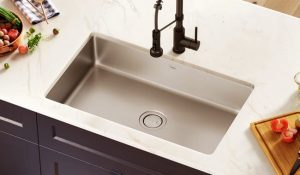
Kraus Kitchen Sink Review | In-depth Analysis
Right now, Kraus is one of the best brands that guarantee safe purchases for homeowners. Most of its kitchen sinks are value for money products.

How do You Measure a Kitchen Sink to Replace It
Measuring the size is a fundamental issue when you need to buy or replace a kitchen sink. Imagine you went to buy a sink and
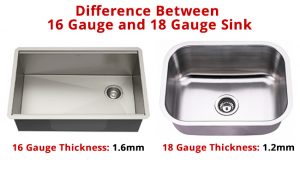
16 Gauge Vs. 18 Gauge Stainless Steel Kitchen Sink
16 Gauge SS Kitchen Sinks are more costly and comfortable than 18 Gauge sinks. But 18 Gauge is also considerable if you are on a






